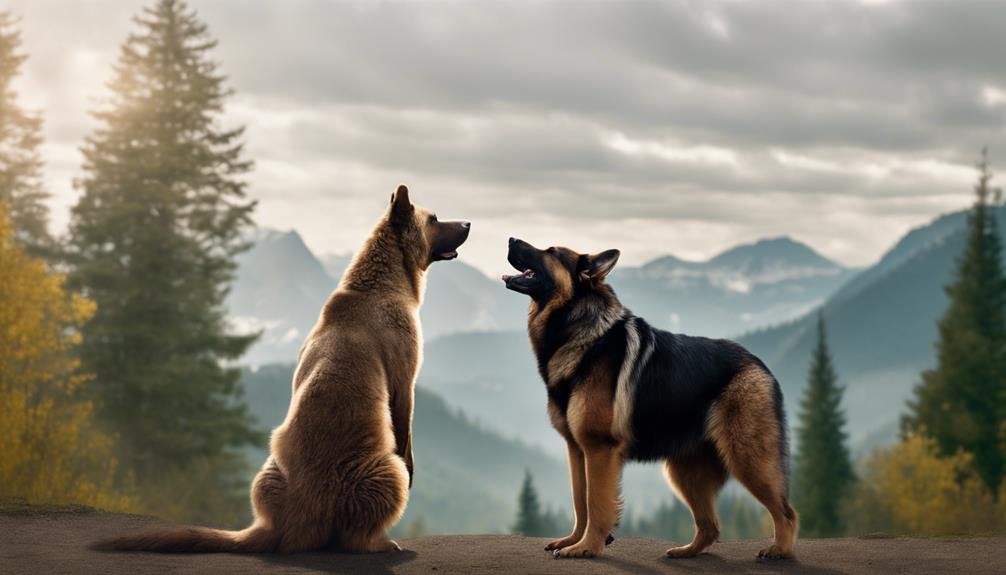Bears and dogs share similarities in their nasal anatomy, featuring large nostrils, hundreds of tiny muscles, and glands that keep receptors moist, enabling them to detect and process scents with remarkable accuracy. However, bears possess the most impressive olfactory system in the animal kingdom, relying almost exclusively on their sense of smell to navigate their environment. Their unique brain structure and specialized snout anatomy enable unparalleled olfactory power, allowing them to detect food sources from great distances and locate potential mates across vast territories. As we explore further, the supremacy of bears' sniffing abilities becomes increasingly apparent.
Key Takeaways
- Bears possess the most impressive olfactory system in the animal kingdom, relying almost exclusively on their sense of smell to navigate their environment.
- Bears' snouts feature 10 million nerve strands and billions of receptors, allowing them to detect scents with unparalleled accuracy and efficiency.
- While dogs have developed impressive olfactory abilities, their sense of smell remains fundamentally limited compared to that of bears.
- A bear's brain is wired to prioritize scent, allowing it to detect and interpret complex chemical signals with remarkable accuracy.
- Bears' superior olfactory power is essential for their survival, enabling them to detect food sources from great distances and locate potential mates across vast territories.
Similarities in Nasal Anatomy
Both dogs and bears possess nasal anatomy featuring large nostrils, hundreds of tiny muscles, a snout for air circulation, and glands that keep receptors moist, underscoring the remarkable similarities in their olfactory hardware. This shared anatomy enables both species to detect and process scents with remarkable accuracy. The snout structure, in particular, plays a vital role in directing airflow and allowing odor molecules to bind to olfactory receptors. The presence of tiny muscles and glands further enhances the sensitivity and efficiency of their olfactory systems. These nasal similarities highlight the convergent evolution of dogs and bears, where both species have developed specialized features to optimize their sense of smell, a key adaptation for survival and success in their respective environments.
Dog Noses: Superhuman but Limited
While a dog's nose is unmistakably superhuman, with some breeds like bloodhounds boasting olfactory abilities that far surpass those of humans, their sense of smell remains fundamentally limited compared to that of bears. Despite their impressive capabilities, dogs have evolved for specific tasks, such as trailing scents, whereas bears have developed their sense of smell as a vital adaptation for survival. Bear adaptations, such as their larger olfactory lobes, have enabled them to thrive in their environment, relying heavily on scent to find food and mates. In contrast, dogs, although remarkable in their own right, have not undergone the same level of scent evolution as bears, leaving them lagging behind in olfactory power.
Bears: Unparalleled Olfactory Power
Possessing the most impressive olfactory system in the animal kingdom, bears have evolved to rely almost exclusively on their sense of smell to navigate their environment, locate food and mates, and ultimately, to survive. Their unparalleled olfactory power is essential for their survival, allowing them to detect food sources from great distances and locate potential mates across vast territories. Bear communication heavily relies on scent marking, where they deposit pheromones on objects to convey information about their identity, sex, and reproductive status. This complex system enables bears to establish social hierarchies, identify potential competitors, and even detect the presence of humans. The importance of scent in bear communication cannot be overstated, as it plays a critical role in their daily lives and long-term survival.
The Bear's Brain: Wired for Smell
The unique structure and organization of a bear's brain, specifically the large olfactory lobes, enable the animal to process scent information with unparalleled efficiency, allowing it to thrive in its environment. This remarkable adaptation is a result of brain evolution, where the olfactory system has been prioritized to facilitate survival.
| Brain Region | Function |
|---|---|
| Olfactory Lobes | Process scent information |
| Hippocampus | Spatial memory and navigation |
| Amygdala | Emotional processing and fear response |
| Cortex | Integrates sensory information |
The bear's brain is wired to prioritize scent, allowing it to detect and interpret complex chemical signals. This remarkable olfactory adaptation has enabled bears to thrive in their environment, where finding food and mates relies heavily on their sense of smell.
Survival Depends on Scent
Survival in the wild is inextricably linked to a bear's ability to detect and interpret scents, making its sense of smell a fundamental component of its existence. The evolution of a bear's nose has led to a highly specialized snout anatomy, with two 9-inch channels containing 10 million nerve strands and billions of receptors. This unique nose evolution has equipped bears with an unparalleled sense of smell, essential for finding food and mates across vast distances. The snout's intricate design, complete with glands for keeping receptors moist, allows for efficient air circulation and odor detection. As a result, bears have developed an unmatched reliance on their sense of smell, making it a pivotal component of their survival and reproductive success.
The Grizzly's Unmatched Sniffing Ability
Routinely, in the domain of olfactory prowess, the grizzly bear stands unparalleled, boasting a sniffing ability that surpasses that of even the most renowned tracking breeds. The grizzly's unmatched sniffing ability is attributed to its unique snout evolution and nostril structure. This is evident in the table below, which compares the olfactory power of grizzly bears, bloodhounds, and humans.
| Species | Olfactory Power |
|---|---|
| Human | 1x |
| Bloodhound | 300x |
| Grizzly Bear | 2,000x |
The grizzly's superior sniffing ability is essential for its survival, allowing it to detect food and mates across long distances. Its snout contains two 9-inch channels, each with 10 million nerve strands and billions of receptors, making it the most impressive olfactory system in the animal kingdom.
Why Bears Dominate the Scent Game
Bears' unparalleled olfactory prowess is rooted in their unique anatomy and brain structure, which have evolved to prioritize scent detection and interpretation. This specialized design allows them to dominate the scent game.
- Unique snout structure featuring two 9-inch channels with 10 million nerve strands and billions of receptors sending information to the brain
- Brain structure dedicated to interpreting scent, with two olfactory lobes the size of a thumb
- Evolutionary pressures favoring bears with exceptional olfactory power for survival and reproductive success
- Nose evolution prioritizing scent detection and interpretation
- Brain wired to prioritize scent, allowing bears to thrive in their environment
Dogs Trail Behind in Olfactory Power
While dogs possess remarkable olfactory abilities, their scent-detection capabilities pale in comparison to those of bears, with even the most skilled canine breed, the bloodhound, being outclassed by the grizzly bear's extraordinary sniffing power. This disparity is a result of bear evolution, where smell adaptation has been vital for survival and reproductive success.
| Species | Olfactory Power | Brain Structure |
|---|---|---|
| Human | 1x | Small olfactory lobe |
| Dog | 100-300x | Medium olfactory lobe |
| Bloodhound | 300x | Large olfactory lobe |
| Grizzly Bear | 2,000x | Two large olfactory lobes |
Bears' reliance on their sense of smell has driven the development of a unique brain structure, prioritizing scent interpretation. This specialization has led to unparalleled olfactory power, making bears the undisputed champions of sniffing supremacy.
A Bear's Sense of Smell: Essential for Survival
A bear's reliance on its sense of smell is crucial for its very survival, as it enables the animal to detect food sources, potential mates, and predators from great distances. This keen sense is a result of brain evolution, where a larger proportion of the bear's brain is dedicated to interpreting scent. This prioritization of scent allows bears to thrive in their environment.
- A bear's sense of smell is essential for finding food, mates, and detecting predators.
- Brain evolution has led to a larger olfactory lobe, allowing for efficient scent processing.
- Scent prioritization enables bears to survive and reproduce successfully.
- A bear's nose is capable of detecting scents from great distances, ensuring survival.
- The unique structure of a bear's brain allows for efficient scent processing, making it essential for survival.
Nature's Favorites: Bears With Good Noses
In the domain of olfactory superiority, natural selection has consistently favored bears with exceptional noses, as this trait has proven critical to their survival and reproductive success. The evolution of a bear's snout has led to the development of a highly specialized olfactory system. The nose muscles, comprising hundreds of tiny muscles, work in tandem to facilitate the intake of air and direct it towards the olfactory receptors. This unique anatomy allows bears to detect scents at incredible distances, making them the undisputed champions of sniffing supremacy. The snout's design, with its two 9-inch channels, enables an immense surface area for odor reception, further amplifying their olfactory prowess. This remarkable adaptation has granted bears an unparalleled edge in their environment, solidifying their position as nature's favorites when it comes to exceptional noses.
Canine Noses: No Match for Bears
Sixteen times more sensitive than a human's, a dog's sense of smell is clearly impressive, but it pales in comparison to the unparalleled olfactory prowess of bears. While dogs have been bred to trail scents, their snout structure and nostril size, although impressive, are no match for the bears' superior olfactory system.
- Bears have a larger surface area in their snouts, allowing for more olfactory receptors.
- A bear's nostrils are larger, allowing for more air to pass through and detect scents.
- The unique structure of a bear's snout contains two 9-inch channels, each with 10 million nerve strands and billions of receptors.
- Bears have a larger proportion of their brain dedicated to interpreting scent, making them more efficient at processing olfactory information.
- A bear's sense of smell is essential for its survival and reproductive success, making it a vital adaptation for their environment.
Frequently Asked Questions
Can Bears Detect Scents Underwater?
Research suggests that bears can detect scents underwater through aquatic tracking, leveraging their exceptional olfactory system; however, diving detection capabilities are unclear, necessitating further study to fully understand their underwater scent-tracking abilities.
How Do Bears' Noses Adapt to Different Environments?
Bears' noses adapt to different environments through a unique nose structure featuring odor filters, allowing them to detect scents in various conditions, from dry air to wet environments, with remarkable accuracy and sensitivity.
Do Bears Have a Preferred Scent for Food or Mates?
Bears exhibit a nuanced olfactory response, with a predilection for sweet, fatty, and protein-rich food scents, while their mating rituals involve subtle pheromonal cues, suggesting a complex interplay between scent and behavior in food preferences and reproductive success.
Can Bears Detect Scents From Their Own Kind?
Bears possess an extraordinary ability for kin detection, enabling them to recognize their mother's scent and distinguish it from others, facilitating mother-cub bonding and social behavior, while also aiding in mate selection and territorial marking.
Can Bears' Sense of Smell Be Affected by Age or Health?
As the golden light of dawn breaks, symbolizing new life, bear cubs develop their olfactory skills, whereas senior bears experience a decline in scent detection, as age-related changes affect the neural pathways, impacting their sense of smell.
Conclusion
In a surprising twist, the canine's celebrated nose, long considered the paragon of olfactory excellence, is eclipsed by the bear's unparalleled sensitivity and processing power. While dogs boast impressive sniffing abilities, their limitations are starkly illuminated by the bear's superior nasal apparatus. Ultimately, the bear's sense of smell emerges as the unequivocal champion, an indispensable tool honed by evolution to facilitate survival in the unforgiving wilderness.









